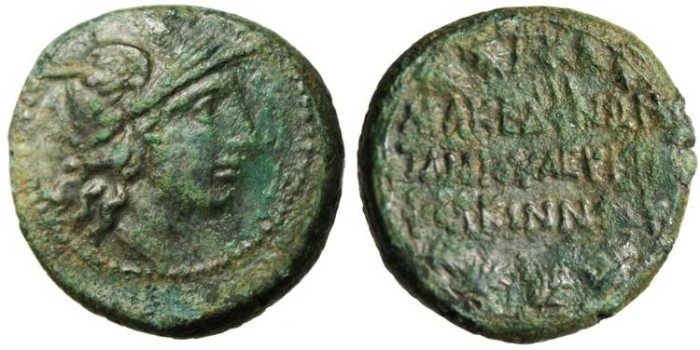
Macedon under Roman Rule, Æ21(9.17g). Lucius Fulcinius, Quaestor, 167 BC. Head of Roma right, wearing winged helmet terminating at the top in the head of a griffin. Border of dots / ΜΑΚΕΔΟΝΩΝ ΤΑΜΙΟΥ ΛΕΥΚΙΟΥ ΦΟΛΚΙΝΝΙΟΥ in three lines within a wreath of oak-leaves. Above, monogram. Line border. MacKay, "Bronze Coinage In Macedonia, 168-166 BC," ANSMN 14 (1968), pp. 6-7, pl.III, 7; BMC Macedonia 80.
This bronze comes from a series struck obviously only over a short period under two quaestors in Macedon. Unfortunately neither Lucius Fulcinnius, nor Gaius Publilius(the other quaestor, whose similar type is pictured here), appear in the history books, so the exact dating of these issues is debated but I believe that the most logical dating is Pierre MacKay's chronology laid out in "Bronze Coinage In Macedonia, 168-166 BC," ANSMN 14 (1968). MacKay argues that, rather than the "After 148/146 B.C." date that many give these types, they should actually be placed in 168-167 B.C., during the period between the victory of Lucius Aemilius Paulus over Perseus in 168 B.C. and his return to Rome in 167 B.C.
MacKay theorizes that Gaius Publilius was the quaestor who followed Paulus into Macedon and struck the initial run of coins from the defeat of Perseus in 168 until Spring 167 B.C. when Fulcinnius was sent to Macedonia to relieve him. Then the Fulcinnius types were struck from Spring-Winter 167 B.C. at which point Paulus returned to Rome to celebrate his triumph. When Rome split Macedon into four "independent" client republics shortly thereafter, MacKay argues that it was likely decided that these coins with Roma on them were simply too strong a symbol of Roman dominance and the decision was made to overstrike them with a new type bearing the image of Silenus on the obverse and "MAKEDONON" on the reverse.
MacKay's dating and hypothesis are backed up by the fact that many of the Silenus types appear to be overstrikes and they are only known to be overstruck on the Roma/Wreath types and not some of the other, potentially less offensive types struck during this period. Additionally, if the argument is correct that the Silenus types were overstruck on the Roma/wreath types due to offense taken by the Macedonian population, it makes much more sense for this to occur at the end of the Third Macedonian War when Rome was at least attempting to present an image of an independent Macedon, rather than at the end of the fourth Macedonian War when Rome officially annexed Macedon and split it into the provinces of Achaea and Epirus. Additionally, Publilius struck some types that were continuations of types in use in Macedon before 168 B.C., further strengthening the dating of these types, and by that same token, the associated Silenus types.
Thanks Romae Aeternae Numismatics for the image!